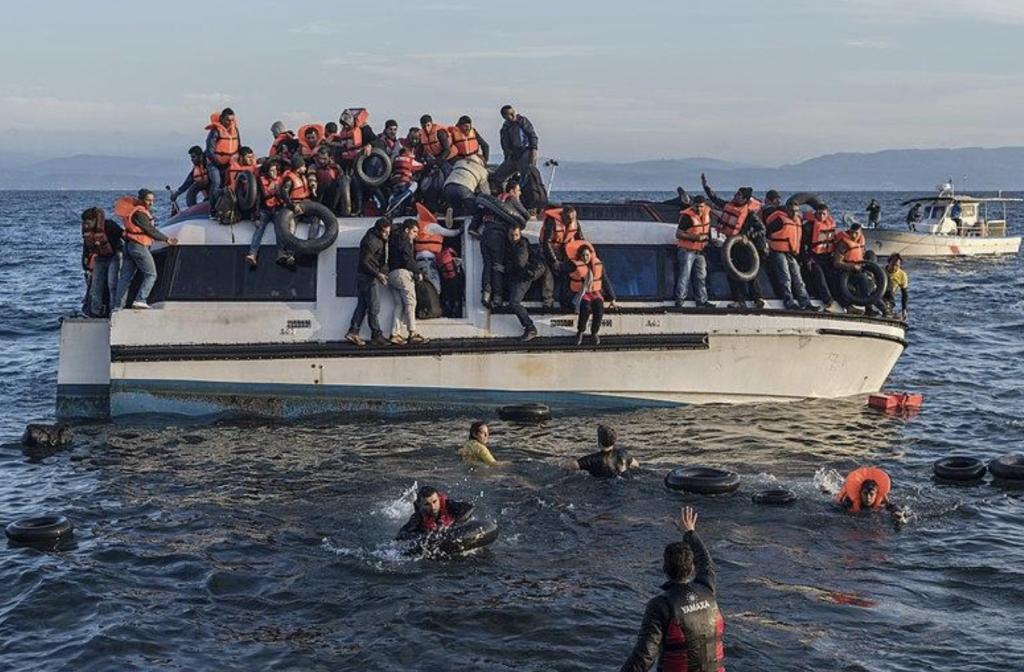
“Syrian and Iraqi refugees at Skala Sykamias Lesvos Greece,” By CC SA.
The political and economic situation in Syria as well as the ongoing civil war due to dissatisfaction with the Assad government has resulted in and perpetuated the current refugee crisis. As of October 2019, the total number of Syrian refugees and displaced peoples has risen to 12.9 million. Since 2011, the Middle East has witnessed a proliferation in popular mobilization against their respective autocratic governments triggered by political reform, a variety of religious and sociopolitical factors, and the deterioration of the economy[i]. However, the international community has up until recently largely overlooked a major underlying issue. As of recent years, studies have linked the current state of climate emergency to the continuous aggravation of the refugee crisis in this region.
The climate crisis refers to the changing of the Earth’s climate that has exceeded scientific expectations[ii] as a consequence of human activities. The effects of this change are numerous and wide-ranging: from rising sea levels to extreme weather events, affecting everything from food production to safe drinking water[iii]. The climate emergency has resulted in conflicts, the loss of lives, and the mass displacement of people. It is those living in marginalized communities as well as developing nations that are most affected[iv]. Said crisis has led to severe droughts in Syria, resulting in a mass migration out of rural areas. This in turn exacerbated the socio-economic stresses that led Syria to civil war and thus a large-scale refugee crisis. The situation was worsened by the lack of effective action taken by the Syrian government[v].
Syria borders the Mediterranean Sea, a region that experiences high natural hydrologic variability, and has thus undergone intense droughts for centuries. In the last hundred years, Syria underwent six significant droughts during which the average level of monthly winter precipitation was recorded to be just one-third of the usual average level [of monthly winter precipitation]. However, between 2006 and 2011 approximately 60% of Syria’s land fell to a multi-season, multi-year drought[vi]. This led to crop failures which resulted in economic tribulation and eventual population displacement as citizens attempted to escape the consequential violence, lack of resources, and the lack of employment opportunities[vii]. By 2011, an estimated 1.5 million people migrated from rural areas due to the effects of the drought[viii]. The five-year drought has been considered “the worst long-term drought and most severe set of crop failures since agricultural civilizations began in the Fertile Crescent many millennia ago.”, according to one expert[ix]. NOAA has since confirmed that the prolonged period of drought in the Mediterranean and Middle East was linked to climate change for two reasons: The rise in global temperatures allows for more evaporation in dry soils and weaker winds leading to less moisture during the wet season from the Mediterranean Sea.
With these droughts often comes conflict over the remaining water supply and greater disenchantment with the government over inaction. Suzanne Saleeby, a writer for the Arab Studies Institute’s magazine, Jadaliyya, has further linked the climate crisis to the country’s political unrest, stating “the regime’s failure to put in place economic measures to alleviate the effects of drought was a critical driver in propelling such massive mobilizations of dissent.”[x]. These “massive mobilizations of dissent” later led to conflict between the government and its people, and the inevitable migration of Syrians fallen victim to the effects of the current climate crisis and political turbulence.
For now, the environmental situation is likely to deteriorate in Syria as the water table continues to lower unless it is addressed appropriately by the Al-Assad government and the international community takes greater strides to combat climate change. If the necessary measures are taken to lessen the threat of climate change, there is a possibility of ameliorating the current refugee crisis in Syria. Preventing the further increase in global temperatures that lead to severe weather events such as droughts and water conservation will prove to be vital in such a cause. Political stability and these reforms would need to go hand in hand as it is unlikely that the current government would prioritize climate action. Said reforms may include more modern irrigation technologies, assessment of crop types and planting patterns, and sustainable groundwater management[xi]. The climate crisis will affect everyone. It will lead to instability, damage of infrastructure, the heightened spread of disease, the uprooting and displacement of enormous numbers of people, mass migration, the deterioration of economies, thus undoubtedly threatening the lives of millions[xii]. Not only in Syria, but across the world will we witness the human race fall at the hands of a man-made climate crisis unless action is taken. Countries and individuals may learn to adapt, but until we hold accountable those who threaten our environment most and fundamentally change the way we treat our planet and all of its inhabitants, we put at risk the wellbeing of our societies and the lives of the most vulnerable.
Edited by Ghayas Osserian
References
[i] Peter H. Gleick, “Water, Drought, Climate Change, and Conflict in Syria”, AMS Publications, July 1, 2014, https://journals.ametsoc.org/doi/full/10.1175/WCAS-D-13-00059.1.
[ii] “Climate Change and Disaster Displacement”, UNHCR, Accessed October 28,2019, https://www.unhcr.org/climate-change-and-disasters.html.
[iii] Emma Tallon, “Climate Change: An Unspoken Factor in the Syrian Civil War”, NAOC, July 25, 2019, http://natoassociation.ca/climate-change-an-unspoken-factor-in-the-syrian-civil-war/.
[iv] S. Nazrul Islam and John Winkel, “Climate Change and Social Inequality”, UN Department of Economic and Social Affairs, October 2017, https://www.un.org/esa/desa/papers/2017/wp152_2017.pdf.
[v] Peter H. Gleick, “Water, Drought, Climate Change, and Conflict in Syria”, AMS Publications, July 1, 2014.
[vi] Francisco Femia and Caitlin Werrell, “Syria: Climate Change, Drought, and Social Unrest”, The Center for Climate and Security, February 29, 2012, https://climateandsecurity.org/2012/02/29/syria-climate-change-drought-and-social-unrest/.
[vii] Francisco Femia and Caitlin Werrell, “Syria: Climate Change, Drought, and Social Unrest”, The Center for Climate and Security, February 29, 2012.
[viii] Emma Tallon, “Climate Change: An Unspoken Factor in the Syrian Civil War”, NAOC, July 25, 2019,
[ix] Gary Nabhan, “Drought Drives Middle Eastern Pepper Farmers Out of Business, Threatens Prized Heirloom Chiles”, Grist Magazine, January 16, 2010, https://grist.org/food/2010-01-15-drought-drives-middle-eastern-peppers/.
[x] Suzanne Saleeby, “Sowing the Seeds of Dissent: Economic Grievances and the Syrian Social Contract’s Unraveling”, Jadaliyya, February 16, 2012, https://www.jadaliyya.com/Details/25271/Sowing-the-Seeds-of-Dissent-Economic-Grievances-and-the-Syrian-Social-Contract%E2%80%99s-Unraveling.
[xi] Peter H. Gleick, “Water, Drought, Climate Change, and Conflict in Syria”, AMS Publications, July 1, 2014.
[xii] Peter H. Gleick, “Water, Drought, Climate Change, and Conflict in Syria”, AMS Publications, July 1, 2014.




